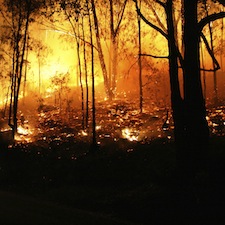Case Study: Biomass Energy Facility, Placer, County, CA
Situation
 The Placer County Department of Planning began discussions about building a wood-fired power plant 10 years ago upon direction from the county’s board of supervisors. The first goal was to reduce greenhouse gas emissions to comply with the state’s clean energy goals. The second was to reduce the local risk of the catastrophic wildfires that threaten the health, economy, and ecology of many forest communities across California. Wildfires severely reduce air quality, which can pose a significant health risk for young children, seniors, and people with asthma and other lung diseases who are especially sensitive to smoke. These fires also destroy homes and businesses and decrease opportunities for tourism and recreation.
The Placer County Department of Planning began discussions about building a wood-fired power plant 10 years ago upon direction from the county’s board of supervisors. The first goal was to reduce greenhouse gas emissions to comply with the state’s clean energy goals. The second was to reduce the local risk of the catastrophic wildfires that threaten the health, economy, and ecology of many forest communities across California. Wildfires severely reduce air quality, which can pose a significant health risk for young children, seniors, and people with asthma and other lung diseases who are especially sensitive to smoke. These fires also destroy homes and businesses and decrease opportunities for tourism and recreation.
Opportunity
The Placer County Department of Planning proposed a wood-to-energy plant. Community members and policymakers were concerned about the potential health impacts of the facility. Sequoia Foundation approached the planning department about using an HIA to identify the health effects as a way to address community concern and inform the decision.
The HIA
The HIA found that the biomass facility will likely benefit community health through improvements in air quality by reducing the risk of wildfires. The facility had the potential to improve air quality both by using forest materials currently disposed of in open-air burn piles (such as wood chips and bark), and by reducing the risk of larger forest fires.
Half of the HIA recommendations focused on easing anxiety and stress in the community regarding air quality, traffic, and noise issues by improving communications from facility management to surrounding areas.
Outcome
The HIA was useful in addressing community concerns about the project. It helped serve as a channel, not associated with the county’s official process, for the community to provide its thoughts and concerns about the proposed facility.
Placer County plans on implementing every single recommendation should the facility be built. It is also exploring how HIAs can be used in informing other potential projects.
A local elected official, Jennifer Montgomery, Placer County 5th district supervisor and chairwoman of the board, whose district includes the site of the proposed facility, applauded the HIA:
“The issues reviewed in the assessment were submitted by community residents who live in the surrounding fire-prone areas. The report’s findings will not only inform those local communities, but other communities across the country that are considering similar alternative energy technologies.”











